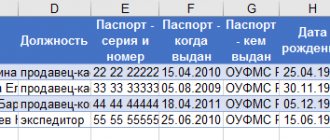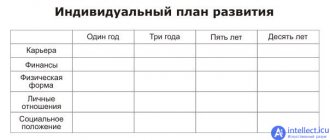What is a cash flow budget and how to prepare it
The enterprise exists and makes a profit by successfully investing money in goods and production, which allows it to generate income. Accordingly, financial flows (for example, expenses and income) are everywhere and must be controlled. It is practically impossible to control what is happening without drawing up a plan and analyzing deviations - this process is called budgeting. Planning the movement of money and analyzing the deviation of reality from plans is BDDS. You need to be able to draw it up, constantly adhere to it and keep reports. Usually they create a BDDS project in Excel, and after that they move on to automating the BDDS in 1C.
What is BDDS
A cash flow budget (CFB) allows you to control cash flows and shows how best to manage them.
The budget includes:
- financial receipts,
- expenditure of funds.
It’s worth saying right away that the difficulty of creating a budget is that costs are known in advance, and income is unpredictable. This is the main difficulty in analysis and forecasting. The budget tries to make them as realistic as possible for a week, month, quarter or year. The goal is to prevent cash gaps, that is, to ensure that payments do not exceed the revenue side of the budget. The ideal situation and global goal is to create a budget where there are more income than expenses. The difficulty of this task depends on many factors. Chief among them is cost management. Spending can always be reduced, but this can easily harm the enterprise. If you keep a budget, then this situation can be avoided, because it is based on optimality.
It is worth remembering that BDDS is not created just like that. This requires documents that are considered sufficient grounds for inclusion in the budget. These include:
- Primary documents: checks, receipts, bank statements.
- Agreements with counterparties.
- BDR - budget of income and expenses.
Why is BDDS needed?
When starting the process of automating accounting for enterprises, they usually start with the BDDS in Excel, and often stop there and do not proceed to launching the BDDS. But this is only sufficient if the organization has no long-term commitments. For example, this applies to payment of payments with significant deferrals.
First of all, trading and manufacturing enterprises should think about compiling a BDDS in 1C, since they belong to organizations with a long financial cycle. For example, a product may be manufactured at the beginning of the calendar year and sold at the end. Accordingly, the revenue will come only in a year. And during this period, the company must have money to maintain the production cycle.
What is included in the cash flow budget
The cash flow budget is quite large as it covers a wide range of activities. To simplify, all operations are formed into three groups, depending on their nature and purpose. Highlight:
- Investment activities.
- Operational activities.
- Financial activities.
Investment activities
Includes any investment of capital that may generate profit in the future. For example, such expenses may include investing enterprise assets in a subsidiary or spending revenue on upgrading equipment. It is also worth remembering that the company can buy securities, real estate, provide loans and borrowings. All this is also considered an investment.
Operating activities
The main goal of an enterprise's operating activities is to make a profit from the final product. Therefore, the costs in this section cover production and sales costs, as well as current needs. For example, you can highlight expenses for:
- product production,
- logistics,
- remuneration of staff,
- maintaining premises and equipment in working order,
- sale of goods.
Operational activities cover not only production, but also storage, distribution and trade. It is worth considering that for each area, operational activities will be unique, since they must correspond to the purpose of the organization’s existence.
Most often, operating activities are the main object when compiling the BDDS, since it primarily suffers in enterprises with a long financial cycle.
Financial activities
The company is interested in attracting additional funds. Sources of finance can be joint-stock companies, individual creditors. This section includes work with credit funds and loans taken out by the organization.
Additional money is not considered revenue; it is always directed inside the enterprise. Funds are used either to cover the gap between expenses and income, or are invested in production, equipment, and personnel.
The downside of financial activity - interest payments, loan repayments
Stages of forecasting
A reliable budget will allow you to understand how to control your expenses: the organization will spend only when you clearly know that you can afford these expenses. The budget will also allow you to see savings information to build cash reserves for the company.
One of the best ways to manage a firm's budget is to create a cash forecast. Such forecasts will be needed to plan financing and allocate resources between different areas of the business. Let's take a look at the basic steps you need to take to make the most of your forecasting capabilities.
Step one.
We start from the pre-launch position. This section will help determine the type and amount of debt and equity financing the business requires, as well as what kind of financing will work best for the company. This section will allow you to determine the amount of initial investment required for organizational measures to open a business, as well as how much money can be spent on launching basic business processes (raw materials—production—sales). To determine the total start-up cost, you need to add the cost of equipment, inventory, land, buildings, loan payments, and start-up costs such as insurance or rent. Once you have the total, you need to subtract that amount from your available funds to find out how much money is left.
Step two.
We determine a sales forecast that will show whether the organization’s cash flow will support the business at the required level. You need to start by finding out what monthly, annual sales will be, and the role of each factor in them. At this stage, you should try to determine whether there is a positive outlook for your industry. If there is a positive outlook, you will need to make a forecast of how many customers will buy your product and what exactly each group of customers will buy from you. Next, you will need to provide a sales forecast for each product or service.
BDDS and BDD: descriptive characteristics
The cash flow budget is often confused with the income and expense budget. These are different things, although they sometimes include repeating parameters. So, in the list of income and expenses (BDR) there will be:
- sources of income,
- directions of expenses,
- volumes of income and expenses,
- profit Loss,
- depreciation,
- difference in currency conversion.
The specificity of BDDS allows you to additionally include in the analysis:
- direction of all cash flows,
- volumes and dates of each payment and receipt,
- turnover of finances at a certain frequency,
- balance of funds in the class on a specific date,
- payment of taxes and loan debts,
- results on working with securities and more.
How to create a BDDS
There are three types of budget:
- in short supply,
- surplus,
- balanced.
It is beneficial for an enterprise to focus on the surplus type, since it has more income than expenses, and the difference between them forms added value, profitability or markup.
To compile it, direct and indirect methods are used. To do this, you need to record all accruals, expenses and income in fact. The volume and date are entered into the budget without adjustment at the time of the operation.
Factors that can be taken into account when using the BDDS by the direct method:
- buyer activity.
- information on suppliers, contractors,
- number of personnel and wages,
- regular payments to funds (for example, social insurance),
- payment of taxes, loans,
- financial transactions with founders and shareholders.
Documents to be used:
- BDR - you need to gain access to it in advance.
- Sales plans with different frequency (quarterly, annual).
- All agreements with suppliers, creditors, customers, etc.
- Bank statements.
Budgeting efficiency
The activity of an enterprise involves, as is known, making a profit.
What is important here is cash flow.
Its result leads to a new production cycle. This allows for the reallocation of limited resources.
BDDS has main parts: income (from sources of funds) and expenses (use of these funds).
The information content of the BDDS is possible if it covers all cash flows. Forecasting cash flow becomes the most important task to ensure the productive activities of the company.
Budgeting efficiency is associated with the presence of end-to-end procedures and regulations at all stages.
The BDDS will be compiled in several stages.
Stage 1. Accounting for all receipts
The revenue plan is based on the sales plan. It indicates the customer, the volume of goods and the date of receipt of funds. At this stage, this is enough - the revenue part has been generated. A situation is considered normal when only the coming months are described in detail, and the distant months are characterized by sparse receipts.
Stage 2. Accounting for all expenses
At this stage, it is necessary to determine where and when the funds will go. Most of the expenses go to pay the main suppliers, but all activities of the organization are taken into account: investment, operating and financial. Costs are indicated for the full financial cycle, and not in fact.
Stage 3. Conditionally standing payments
This takes into account other expenses that are included in operating activities: taxes, utility bills, advertising and development costs, wages, and maintenance of premises. Based on regulatory documents, the frequency with which calculations are made for these items is established. It is allowed to enter average values rather than exact dates.
For those expenses that will be single (advertising campaign), a separate column is created.
Stage 1-3 cover the operational activities of the enterprise.
Stage 4. Investment activity
The basis for creating this part of the BDDS can be an investment plan, a capital expenditure project or a BDDS. If there are no such documents, then you need to talk with the company’s employees who deal with financial issues. It is also recommended to approve the investment plan for the current year with your boss.
In this case, it is worth taking into account not only expenses, but also income from investment activities: loan interest, dividends, payments on shares and securities.
Step 5. Financial activities
This section is needed to place available funds in deposits, earn interest on bonds, work with creditors and overdraft. The main goal here is to find money, both from internal and external sources.
Main types of enterprise payment calendars
Payment calendars are divided into types according to the areas of work of the enterprise, its divisions and departments. The following types of this document are distinguished:
- Tax payment calendar, which is also called the tax payment schedule, where contributions made to the tax authorities are recorded. The payment date is usually set to the last day of the period allocated for the transfer of funds.
- Accounts receivable collection calendar. All necessary data is entered into the document within the time limits specified in agreements with counterparties. The date of credit to the current account is used as the date of receipt of money, since in this way it is possible to represent the actual turnover of funds.
- Loan servicing calendar. All information on payments is indicated in this document based on the terms of credit/leasing agreements.
- Salary payment calendar. Used in companies working with a multi-stage salary payment schedule.
- Budget for the formation of industrial reserves. Information on these payments is entered in accordance with procurement plans or agreements concluded with counterparties. The same document must contain data in case of payment of debts to suppliers.
- Management expenses budget. It includes the costs of purchasing licenses, office equipment, that is, everything that does not belong to non-current assets, as well as expenses for business trips, postage, and other types of expenses necessary for managing the company. Please note that this does not include remuneration for administrative and managerial personnel; it is recorded in the salary payment calendar. The amount in this case is established by the corresponding estimate, and the timing is agreed upon with management services.
- Product sales budget. There are two sections here: “Schedule of receipt of payments for sold products”, as well as “Schedule of expenses that ensure the sale of products”.
- Budget for the formation of a portfolio of long-term financial investments. This document also includes two sections: “Schedule of costs for the acquisition of long-term financial investment instruments” (such as shares, long-term bonds, etc.) and “Schedule of receipt of dividends and interest on long-term financial instruments of the investment portfolio.”
- Capital budget for the implementation of the real investment program. When compiling it, two sections are taken into account: “Schedule of capital expenditures” (for payment of fixed assets and intangible assets) and “Schedule of receipt of investment resources” (for individual sources).
- Capital budget for the implementation of investment projects. This variation is similar to the previous document.
- Share issue budget. The document includes a “Schedule of payments ensuring the preparation of the issue of shares and ensuring their sale” (commission, etc.) and a “Schedule of receipt of funds from the issue of shares.”
- The bond issue budget is similar to the previous type of document.
- Principal amortization calendar for financial loans. Payment information is recorded separately for all types of loans and in accordance with the terms of loan agreements.
conclusions
The presence of a BDDS gives an enterprise a significant advantage. However, it is worth remembering that making a plan is only half the battle, as it must be adhered to. Deviations are permissible in case of force majeure and the emergence of new factors.
The Finoko web service allows you to automate the calculation of BDDS. The service allows you to determine the structure of cash flow items. A convenient system for managing formulas in indicators makes it possible to automate the planning process and create a comprehensive financial model of the company. The Management Accounting module in 1C allows you to download actual data on the movement of money on current accounts and in the cash register of an enterprise.
0
Disclosure of information on three cash flows
The Regulations establish requirements for information disclosure, including: - the procedure for providing additional explanations is provided; — the need has been established to link the amounts presented in the report with the corresponding balance sheet items; — the composition of the disclosed information is determined.
Structurally, PBU 23/2011 divides cash flow into three flows: cash flow in the context of current activities reveals the monetary content of profit, investment activity shows the trend in the long-term development of the organization, and financial flow reflects the organization’s ability to attract money from outside.
If we expand on these concepts in more detail, we can say the following:
Current activities are the usual activities of the organization: production of products, performance of work, provision of services, sale of goods, rental of property, etc.
Investment activity is the acquisition and sale of land, real estate, equipment, intangible assets and other non-current assets; construction on our own; expenses for research, development and technological development. Investment activities also include the provision of loans to other organizations and making other financial investments (purchase of securities of other organizations, including debt, contributions to the authorized (share) capital of other organizations, etc.).
Financial activity is considered to be the activity of an organization, as a result of which the amount and composition of equity capital and borrowed funds changes (proceeds from the issue of shares, bonds, receipt of loans from other organizations, repayment of borrowed funds, etc.)*.
Note: * read more about the classification of cash flows and the reflection of transactions (including foreign exchange) in the cash flow statement in accordance with PBU 23/2011 on our website.









